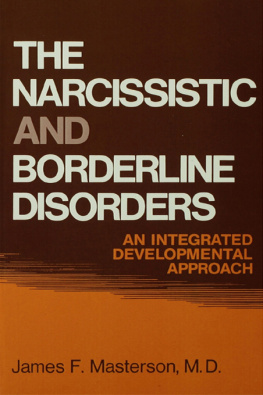SPLIT
Understanding and Treating Borderline, Narcissistic, and Schizoid Disorders
Philip Manfield, Ph.D
Split Self/Split Object helps clinicians to diagnose personality disorders, understand patients' experiences of these disorders, and provide effective psychotherapy. It is written from the perspective of clinical practice with a minimum of theory. The capacity to be empathic with a patient's inner feeling states depends on the ability to understand the meaning of the patient's comments and behavior. This is difficult with patients who have personality disorders because their perception of reality is distorted by their propensity for splitting. The task for the therapist is complicated with them by their sudden swings in attitude toward the therapist and by their tendency to view those attitudes as reality based. Patients with personality disorders speak a foreign language; they use familiar words but in some instances with meanings uniquely shaped by the way they experience the world. This book will improve the therapist's fluency in the language of personality disordered patients.
The protective mechanisms used by these patients are relatively primitive and maladaptive, interfering with their functioning and sometimes making their lives and their therapy sessions chaotic. Split Self/Split Object presents an understanding of the inner dynamics of these patients that explains many otherwise confusing clinical phenomena, details a way of tracking clinical events that makes them understandable, and offers a variety of useful forms of intervention.
The first chapter discusses some of the differences in characteristics and treatment between neurotic and personality-disordered patients. The second focuses on common maladaptive defenses used by these patients, giving clinical examples of each and offering useful therapeutic responses. Chapters Three through Five focus in turn on borderline, narcissistic, and schizoid disorders, and include transcript material to provide clear examples of how these patients appear in treatment and how they can and cannot be treated. Chapter Five, the chapter about the schizoid disorder, will be of particular interest to clinicians at all levels of psychotherapeutic work.
Chapter Six describes a practical approach to differential diagnosis, presenting it as an ongoing process for deepening one's understanding of a patient. This chapter addresses the clinician's actual experience with patients, describing specific points the therapist must consider in evaluating an apparent discrepancy
(continued on back flap)
Split Self/ Split Object
Digitized by the Internet Archive in 2012
http://archive.org/details/splitselfsplitobOOmanf
Split Self/ Split Object
Understanding and Treating Borderline, Narcissistic, and Schizoid Disorders
Philip Manfield, Ph.D.
&
JASON ARONSON INC.
Northvale, New Jersey London
This book was set in 11/13 Baskerville by Lind Graphics of Upper Saddle River, New Jersey.
It was printed and bound by Haddon Craftsmen of Scranton, Pennsylvania.
Copyright 1992 by Philip Manfield *
10 987654321
All rights reserved. Printed in the United States of America. No part of this book may be used or reproduced in any manner whatsoever without written permission from Jason Aronson Inc. except in the case of brief quotations in reviews for inclusion in a magazine, newspaper, or broadcast.
Excerpt(s) from ORDINARY PEOPLE. Copyright 1980 by Paramount Pictures.
All rights reserved. Used by permission.
ELEANOR RIGBY. Words and Music by John Lennon and Paul McCartney Copyright 1966 by NORTHERN SONGS. All rights controlled and administered by MCA MUSIC PUBLISHING, A Division of MCA INC., New York, NY 10019. Under license from NORTHERN SONGS.
NOWHERE MAN. Words and Music by John Lennon and Paul McCartney Copyright 1965 by NORTHERN SONGS. All rights controlled and administered by MCA MUSIC PUBLISHING, A Division of MCA INC., New York, NY 10019. Under license from NORTHERN SONGS.
Song lyrics used by permission. International copyright secured. All rights reserved.
Library of Congress Cataloging-in-Publication Data Manfield, Philip
Split Self/Split Object : Understanding and Treating Borderline, Narcissistic, and Schizoid Disorders / by Philip Manfield. p. cm.
Includes bibliographical references and index.
ISBN 0-87668-460-6
1. Personality disorders Treatment. 2. Borderline personality disorder Treatment.
3. Narcissism Treatment. 4. Schizoid personality Treatment. 5. Psychotherapy. I. Tide.
[DNLM: 1. Borderline Personality Disorder therapy.
2. Narcissism. 3. Psychoanalytic Therapy. 4. Schizoid Personality Disordertherapy. WM 190 M276e]
RC554.M26 1992 616.85 85' dc20 DNLM/DLC
for Library of Congress 91-44052
Manufactured in the United States of America. Jason Aronson Inc. offers books and cassettes. For information and catalog write to Jason Aronson Inc., 230 Livingston Street, Northvale, New Jersey 07647
To My Dad
Contents
Acknowledgments
Introduction
Part I
1 Personality Disorders
The Nature of a Personality Disorder
Differences between a Personality Disorder and a Neurosis Four Categories of Personality Disorder Role of Maladaptive Defenses in Therapy Conclusion
2 Defenses
Resistance to Treatment Clinging Defenses Distancing Defenses Narcissistic Defenses
Relationship between Symptoms and Defenses
Hierarchy of Defenses
Conclusion
Borderline Splitting Characteristics of Borderline Disorders Treatment of the Borderline Disorder Clinical Example Runaway Treatment Clinical Example Confrontation with a High-level Borderline Disorder Comparison of Two Approaches to Treatment Phases of Treatment Countertransference Conclusion
4 Narcissistic Disorders
Behavioral Characteristics of the Narcissistic Disorder
Exhibitionistic and Closet Narcissistic Disorders
Selfobject Transferences
An Exhibitionistic Narcissistic Disorder
Narcissistic Splitting
Narcissistic Vulnerability
A Closet Narcissistic Disorder
Origins of the Narcissistic Disorder
Treatment of the Narcissistic Disorder
Comparison of Two Approaches to Treatment
Obstacles to Treatment
Clinical Example Countertransference with an Exhibitionistic Narcissistic Disorder Clinical Example A Higher Level Exhibitionistic Narcissistic Disorder Clinical Example Countertransference Controlled Conclusion
5 Schizoid Disorders
Characteristics of the Schizoid Personality Clinical Example Schizoid Adaptation Harry Guntrip
Treatment of the Schizoid Disorder
Schizoid Splitting
Clinical Example Schizoid Splitting and the In and Out Programme
Differential Diagnosis between Schizoid Disorder and Dissociative Disorder Conclusion
Part III
6 Differential Diagnosis 241
Neurosis vs. Personality Disorder Types of Personality Disorders Practical Problems in Diagnosis
Initial Diagnosis Establishing a Working Hypothesis Diagnosis by Intervention
Diagnostic Implications of Precipitating Events and Presenting Problems Diagnostic Implications of Personal History Diagnostic Implications of Split Self and Object Representations Diagnostic Information in Countertransference Diagnostic Implications of Defenses Conclusion
7 Interventions 283
Confrontation
Clinical Example Consistent Confrontation
Some Factors Affecting the Use of Confrontation
Gradations of Confrontation
Interpretation
Transference Interventions
Exploratory and Educational Interventions
Alcohol Interventions in Neutral Psychotherapy
Clinical Example Confronting Alcoholism
Conclusion



